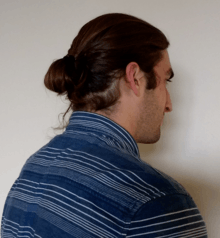Bun (hairstyle)
A bun is a type of hairstyle wherein the hair is pulled back from the face, twisted or plaited, and wrapped in a circular coil around itself, typically on top or back of the head or just above the neck. A bun can be secured with a barrette, bobby pins, one or more hair sticks, a hairnet, or a pen or pencil. Hair may also be wrapped around a piece called a "rat".[1][2] Alternatively, hair bun inserts, or sometimes rolled up socks, may also be used to create donut-shaped buns.[3] Buns may be tightly gathered, or loose and more informal.
Double bun

Double or pigtail buns are often called odango[4] (お団子 odango), which is also a type of Japanese dumpling (usually called dango; the o- is honorific).
The term was popularized by the anime and manga series Sailor Moon , whose eponymous heroine, her mother during the Ancient Silver Millennium, Queen Serenity, and her future daughter from the 30th Century Silver Millennium, Chibiusa (although Chibiusa's are more conical than spherical), all wear their hair in this style. They also wear two pigtails of hair that hang down from the two spherical buns, but this is not universal to the term's usage within Japan itself. The term odango in Japanese can refer to any variety of bun hairstyle.
In China, the hairstyle is called niújiǎotóu (牛角头).[5] It was a commonly used hairstyle up until the early 20th century, and can still be seen today when traditional attire is used. This hairstyle differs from the odango slightly in that it is gender neutral; Chinese paintings of children have frequently depicted girls as having matching ox horns, while boys have a single bun in the back.
Man bun
Man buns were worn in China as early as 200BC as depicted on the terracotta soldiers. They were worn until the end of the Ming Dynasty in AD 1644, after which the Qing Dynasty government enforced Han Chinese to adopt the queue hairstyle (queue order).

The term "man bun" is a term used to describe long-haired men who do not wish to sport the traditional trend of short back and sides wearing their hair in a topknot. In Asia, it originated in 16th century Japan as the traditional hairstyle for samurai warriors and sumo wrestlers. In the west, topknots were frequently worn by "barbarian" peoples in the eyes of the Romans, such as the Goths, Vandals, and most importantly, the Lombards. Later, the hairstyle survived in the pagan Scandinavian north (some believe the topknot hairstyle contains elements of Odinic cult worship) and with the eastern nomadic tribes such as the Bulgars, Cumans and Cossacks. Paul the deacon, in his description of the traditional barbarian style of the Lombard nation, describes their hair thus so, "they uncovered the flesh of their heads by shaving all around the neck, sides, and back of the head until the nuchal zone. The hair on the top, left long, was parted in the middle and hung down to the corners of their mouths." (HL IV.22). This perfectly describes the modern western top knot as it appears untied.
Historical and iconic examples of men with long hair using this style as practicality include:
- Shiva
- 6th-7th century BCE — Buddha
- 3rd century BCE—Terracotta Warriors of China
- Gareth Bale
- David Beckham
- Bradley Cooper[6][7][8][9]
- Leonardo DiCaprio
- Josh Donaldson
- Colin Farrell
- Kit Harington
- George Harrison, in the 1970s
- Andrew Hozier-Byrne
- Zlatan Ibrahimović
- Jared Leto
- Jeremy Lin[10]
- Clay Matthews III
- Joakim Noah
- Jared Padalecki
- Brad Pitt
- Saahil Prem
- Harry Styles
- Lin-Manuel Miranda (during his Hamilton run and during interviews) he has since chopped it
- Ricky Holmes

Modern style
The modern man bun style is reported to have started in London around 2010[11] with the first Google Trends examples started to appear in 2013 and searches showed a steep increase through 2015. Some of the first celebrities to wear the style were Jared Leto, Joakim Noah, Chris Hemsworth, Leonardo DiCaprio, and Orlando Bloom. The hairstyle is also associated with Brooklyn hipsters.[12]
See also
References
- ↑ "Hair Rats: Creating Voluminous, Perfect Buns". Bouffants and Beehives. August 3, 2012.
- ↑ "Hair Rats". Pin Curl Magazine. May 1, 2010.
- ↑ "Rise of the 'sock bun': How to master the hipster updo that is fast becoming the height of hair fashion". Mail Online. Retrieved 2016-11-24.
- ↑ Lowery, Allison (2013). "Appendix 1, Glossary of Hairstyling Terms". Historical Wig Styling: Ancient Egypt to the 1830s. Taylor & Francis. p. 259. ISBN 9780240821238.
- ↑ "颜值自信者请进!学扎明星同款牛角头". 爱美女性网. Retrieved 19 October 2016.
- ↑ "The Five Best Man Buns in Sports". 22 December 2014. Retrieved 5 July 2017.
- ↑ "Now Trending: The Man Bun". 19 November 2013. Retrieved 5 July 2017.
- ↑ Mokoena, Tshepo; Carpentier, Megan (21 December 2014). "Man-buns are the sexiest thing in the world. This is why they drive us wild". Retrieved 5 July 2017 – via The Guardian.
- ↑ "Scientific Proof That All Celebrity Men Are Hotter With Man Buns". Retrieved 5 July 2017.
- ↑ https://nothinbutnets.com/2016/09/02/jeremy-lin-hair-update-2/
- ↑ Cochrane, Lauren (2013-10-16). "Man buns: a hair-raising trend". The Guardian. Retrieved 2017-07-12.
- ↑ Edwards, Phil (2015-09-22). "Man buns, explained". Vox Media. Vox Media, Inc. Retrieved 2017-07-12.
External links
![]() Media related to Bun hairstyle at Wikimedia Commons
Media related to Bun hairstyle at Wikimedia Commons